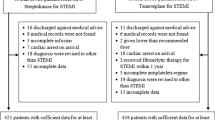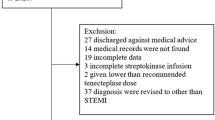Abstract
Little is known about the impact of thrombolytic agents on in-hospital outcomes in the Middle East. The objective of this study was to evaluate the impact of thrombolytic agents on in-hospital outcomes in ST-segment elevation myocardial infarction (STEMI) patients in six Middle Eastern countries. Gulf Registry of Acute Coronary Events was a prospective, multinational, multicentre, observational survey of consecutive acute coronary syndrome patients admitted to 65 hospitals in 2006 and 2007. Out of 1,765 STEMI patients admitted to hospitals within 12 h of symptoms onset, 25, 43, and 30% were treated with streptokinase, reteplase, and tenecteplase, respectively. Median age of the study cohort was 50 (45–59) years and majority were males (89%). The overall median symptom onset-to-presentation and median door-to-needle times were 130 min (65–240) and 45 min (30–75), respectively. Streptokinase patients had worse GRACE risk scores compared to patients who received fibrin specific thrombolytics. Academic hospitals and cardiologists as admitting physicians were associated with the use of fibrin specific thrombolytics. After significant covariate adjustment, both reteplase [odds ratio (OR), 0.38; 95% CI: 0.18–0.79; P = 0.009] and tenecteplase (OR, 0.30; 95% CI: 0.12–0.77; P = 0.012) were associated with lower all-cause in-hospital mortality compared with streptokinase. No significant differences in other in-hospital outcomes were noted between the thrombolytic agents. In conclusion, in light of the study’s limitations, fibrin specific agents, reteplase and tenecteplase, were associated with lower all-cause in-hospital mortality compared to the non-specific fibrin agent, streptokinase. However, the type of thrombolytic agent used did not influence other in-hospital outcomes.
Similar content being viewed by others
References
Media centre (2011) Cardiovascular diseases (CVDs). http://www.who.int/mediacentre/factsheets/fs317/en/index.html/. Accessed 25 Dec 2011
Ramahi TM (2010) Cardiovascular disease in the Asia Middle East region: global trends and local implications. Asia Pac J Public Health 22:S83–S89
Kushner FG, Hand M, Smith SC Jr et al (2009) American College of Cardiology Foundation/American Heart Association Task Force on Practice Guidelines 2009. Focused updates: ACC/AHA guidelines for the management of patients with ST-elevation myocardial infarction (updating the 2004 guideline and 2007 focused update) and ACC/AHA/SCAI guidelines on percutaneous coronary intervention (updating the 2005 guideline and 2007 focused update): a report of the American College of Cardiology Foundation/American Heart Association Task Force on Practice Guidelines. Circulation 120:2271–2306
Van de Werf F, Bax J, Betriu A et al (2008) ESC Committee for Practice Guidelines. Management of acute myocardial infarction in patients presenting with persistent ST-segment elevation: the task force on the management of st-segment elevation acute myocardial infarction of the European Society of Cardiology. Eur Heart J 29:2909–2945
The GUSTO investigators (1993) An international randomized trial comparing four thrombolytic strategies for acute myocardial infarction. N Engl J Med 329:673–682
Fibrinolytic Therapy Trials’ (FTT) Collaborative Group (1994) Indications for fibrinolytic therapy in suspected acute myocardial infarction: collaborative overview of early mortality and major morbidity results from all randomized trials of more than 1000 patients. Lancet 343:311–322
International Joint Efficacy Comparison of Thrombolytics (INJECT) Investigators (1995) Randomised, double-blind comparison of reteplase double-bolus administration with streptokinase in acute myocardial infarction (INJECT): trial to investigate equivalence. Lancet 346:329–336
Zubaid M, Rashed WA, Almahmeed W, Al-Lawati J, Sulaiman K, Al-Motarreb A, Amin H, Al Suwaidi J, Alhabib K (2009) Management and outcomes of Middle Eastern patients admitted with acute coronary syndromes in the Gulf Registry of Acute Coronary Events (Gulf RACE). Acta Cardiol 64:439–446
Awad HH, Zubaid M, Alsheikh-Ali AA, Al Suwaidi J, Anderson FA Jr, Gore JM, Goldberg RJ (2011) Comparison of characteristics, management practices, and outcomes of patients between the global registry and the gulf registry of acute coronary events. Am J Cardiol 108:1252–1258
Zubaid M, Rashed WA, Al-Khaja N et al (2008) Clinical presentation and outcomes of acute coronary syndromes in the gulf registry of acute coronary events (Gulf RACE). Saudi Med J 29:251–255
Cannon CP, Battler A, Brindis RG et al (2001) American College of Cardiology key data elements and definitions for measuring the clinical management and outcomes of patients with acute coronary syndromes. A report of the American College of Cardiology Task Force on Clinical Data Standards (Acute Coronary Syndromes Writing Committee). J Am Coll Cardiol 38:2114–2130
Lemeshow S, Hosmer DWJ (1982) A review of goodness of fit statistics for use in the development of logistic regression models. Am J Epidemiol 115:92–106
McNamara RL, Herrin J, Bradley EH et al (2006) Hospital improvement in time to reperfusion in patients with acute myocardial infarction, 1999–2002. J Am Coll Cardiol 47:45–51
Zijlstra F, Patel A, Jones M et al (2002) Clinical characteristics and outcome of patients with early (<2 h), intermediate (2–4 h) and late (>4 h) presentation treated by primary coronary angioplasty or thrombolytic therapy for acute myocardial infarction. Eur Heart J 23:550–557
Newby LK, Rutsch WR, Califf RM et al (1996) Time from symptom onset to treatment and outcomes after thrombolytic therapy. GUSTO-1 Investigators. J Am Coll Cardiol 27:1646–1655
Goldberg RJ, Mooradd M, Gurwitz JH, Rogers WJ, French WJ, Barron HV, Gore JM (1998) Impact of time to treatment with tissue plasminogen activator on morbidity and mortality following acute myocardial infarction (The Second National Registry of Myocardial Infarction). Am J Cardiol 82:259–264
Mathews R, Peterson ED, Li S, Roe MT, Glickman SW, Wiviott SD, Saucedo JF, Antman EM, Jacobs AK, Wang TY (2011) Use of emergency medical service transport among patients with st-segment-elevation myocardial infarction: findings from the national cardiovascular data registry acute coronary treatment intervention outcomes network registry-get with the guidelines. Circulation 124:154–163
Fares S, Zubaid M, Al-Mahmeed W et al (2010) Utilization of emergency medical services by patients with acute coronary syndromes in the Arab Gulf States. J Emerg Med 41:310–316
Spencer FA, Montalescot G, Fox KA et al, for Global Registry of Acute Coronary Events (GRACE) Investigators (2010) Delay to reperfusion in patients with acute myocardial infarction presenting to acute care hospitals: an international perspective. Eur Heart J 31:1328–1336
Glickman SW, Cairns CB, Chen AY, Peterson ED, Roe MT (2010) Delays in fibrinolysis as primary reperfusion therapy for acute ST-segment elevation myocardial infarction. Am Heart J 159:998–1004.e2
Schiele F, Hochadel M, Tubaro M et al (2010) CPACS Investigators. Reperfusion strategy in Europe: temporal trends in performance measures for reperfusion therapy in ST-elevation myocardial infarction. Eur Heart J 31:2614–2624
Bi Y, Gao R, Patel A et al (2009) CPACS Investigators. Evidence-based medication use among Chinese patients with acute coronary syndromes at the time of hospital discharge and 1 year after hospitalization: results from the Clinical Pathways for Acute Coronary Syndromes in China (CPACS) study. Am Heart J 157:509–516
Dragu R, Behar S, Sandach A et al (2006) Should primary percutaneous coronary intervention be the preferred method of reperfusion therapy for patients with renal failure and ST-elevation acute myocardial infarction? Am J Cardiol 97:1142–1145
Granger CB, Steg PG, Peterson E et al (2005) GRACE Investigators. Medication performance measures and mortality following acute coronary syndromes. Am J Med 118:858–865
Bode C, Smalling RW, Berg G et al (1996) Randomized comparison of coronary thrombolysis achieved with double-bolus reteplase (recombinant plasminogen activator) and front-loaded, accelerated alteplase (recombinant tissue plasminogen activator) in patients with acute myocardial infarction. The RAPID II Investigators. Circulation 94:891–898
The GUSTO III Investigators (1997) A comparison of reteplase with alteplase for acute myocardial infarction. N Engl J Med 337:1118–1123
Cannon CP, Gibson CM, McCabe CH et al (1998) TNK-tissue plasminogen activator compared with front-loaded alteplase in acute myocardial infarction: results of the TIMI 10B trial. Circulation 98:2805–2814
The ASSENT-2 Investigators (1999) Single-bolus tenecteplase compared with front-loaded alteplase in acute myocardial infarction: the ASSENT-2 double-blind randomised trial. Assessment of the safety and efficacy of a new thrombolytic. Lancet 354:716–722
Dundar Y, Hill R, Dickson R, Walley T (2003) Comparative efficacy of thrombolytics in acute myocardial infarction: a systematic review. Quart J Med 96:103–113
Giraldez RR, Wiviott SD, Nicolau JC, Mohanavelu S, Morrow DA, Antman EM, Giugliano RP (2009) Streptokinase and enoxaparin as an alternative to fibrin-specific lytic-based regimens: an ExTRACT-TIMI 25 analysis. Drugs 69:1433–1443
Sabatine MS, Cannon CP, Gibson CM et al (2005) Addition of clopidogrel to aspirin and fibrinolytic therapy for myocardial infarction with ST-segment elevation. N Engl J Med 352:1179–1189
Clopidogrel and Metoprolol in Myocardial Infarction Trial (COMMIT) Collaborative Group (2005) Addition of clopidogrel to aspirin in 45,852 patients with acute myocardial infarction: randomised placebo-controlled trial. Lancet 366:1607–1621
Acknowledgments
Gulf RACE was sponsored by the Gulf Heart Association and was financially supported by a grant from Sanofi Aventis and Qatar Telecommunications Company. The financial sponsors had no role in study design, data collection, data analysis, writing of the report or submission of the manuscript. The authors declare no conflicts of interest with respect to the authorship and/or publication of this article. The authors would like to thank the patients, physicians, nurses, and support staff who participated in Gulf RACE registry for their invaluable contribution and cooperation.
Author information
Authors and Affiliations
Corresponding author
Rights and permissions
About this article
Cite this article
Al-Zakwani, I., Ali, A., Zubaid, M. et al. Impact of type of thrombolytic agent on in-hospital outcomes in ST-segment elevation myocardial infarction patients in the Middle East. J Thromb Thrombolysis 33, 280–286 (2012). https://doi.org/10.1007/s11239-012-0698-6
Published:
Issue Date:
DOI: https://doi.org/10.1007/s11239-012-0698-6




